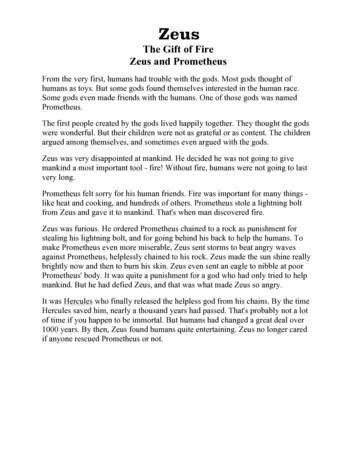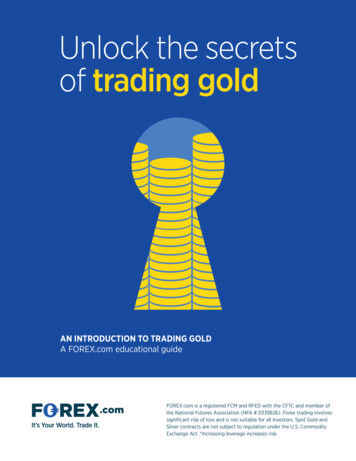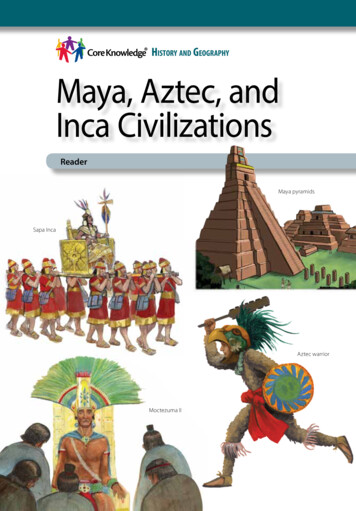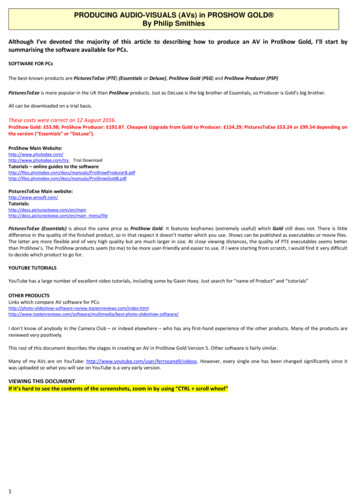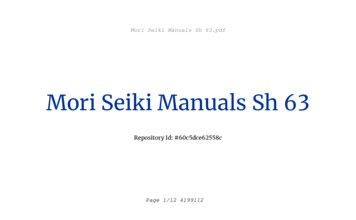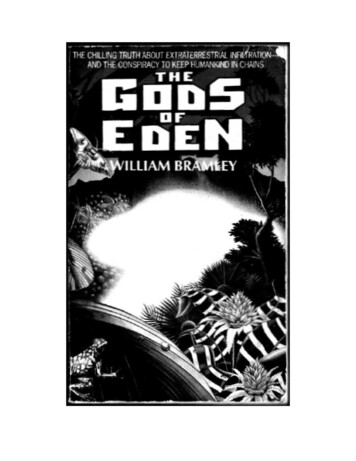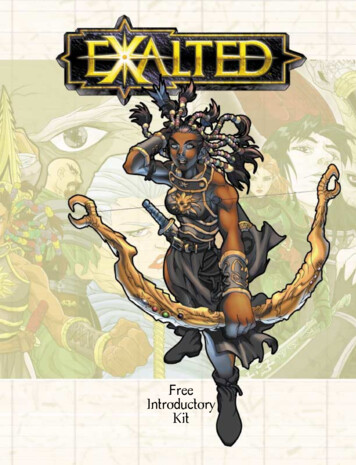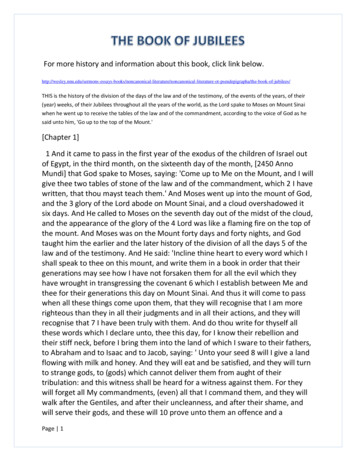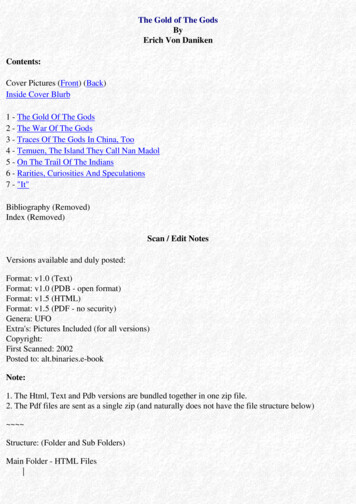
Transcription
The Gold of The GodsByErich Von DanikenContents:Cover Pictures (Front) (Back)Inside Cover Blurb1 - The Gold Of The Gods2 - The War Of The Gods3 - Traces Of The Gods In China, Too4 - Temuen, The Island They Call Nan Madol5 - On The Trail Of The Indians6 - Rarities, Curiosities And Speculations7 - "It"Bibliography (Removed)Index (Removed)Scan / Edit NotesVersions available and duly posted:Format: v1.0 (Text)Format: v1.0 (PDB - open format)Format: v1.5 (HTML)Format: v1.5 (PDF - no security)Genera: UFOExtra's: Pictures Included (for all versions)Copyright:First Scanned: 2002Posted to: alt.binaries.e-bookNote:1. The Html, Text and Pdb versions are bundled together in one zip file.2. The Pdf files are sent as a single zip (and naturally does not have the file structure below) Structure: (Folder and Sub Folders)Main Folder - HTML Files
- {Nav} - Navigation Files - {PDB} - {Pic} - Graphic files - {Text} - Text File-Salmun
Inside Cover BlurbThroughout the world Erich von Daniken's first two books -CHARIOTS OF THE GODS? and, morerecently, RETURN TO THE STARS-have been massive bestsellers.GOLD OF THE GODS marks the culmination of an arduous world-wide expedition taking the author76,000 miles through Ceylon, Singapore, Malaysia, Guam, Polynesia, Easter Island, Taiwan, Chile,Brazil, Colombia, San Salvador and various States of North America. Wherever he went, startlingevidence emerged to bolster his main contention that long ago planet earth hosted extraterrestrialbeings. As his expedition gained momentum von Daniken's suspicions of a sensational Battle of theGods way back before the dawn of recorded history were given fresh credibility.Within the framework of the beliefs and ideas of the last thousand years many improbable treasures,and fantastic ruins would appear inexplicable. But when we look at them in the light of the most up-todate technology then these important and startling discoveries are explicable . then we can recall andacknowledge the incredible Era of the Gods.
1 - The Gold Of The GodsTo me this is the most incredible, fantastic story of the century. It could easily have come straightfrom the realms of Science Fiction if I had not seen and photographed the incredible truth in person.What I saw was not the product of dreams or imagination, it was real and tangible.A gigantic system of tunnels, thousands of miles in length and built by unknown constructors at someunknown date, lies hidden deep below the South American continent. Hundreds of miles ofunderground passages have already been explored and measured in Ecuador and Pent. That is only abeginning, yet the world knows nothing about it.On July 21, 1969, Juan Moricz, an Argentine subject, deposited a legal title-deed (Fig. 1) signed byseveral witnesses with Dr. Gustavo Falconi, a notary in Guayaquil. The deed sets out Moricz's claimto be the discoverer of the tunnels as far as the Republic of Ecuador and posterity are concerned. I hadthis document, which was written in Spanish, translated by a UN interpreter. I quote the mostimportant parts of it at the beginning of this incredible story of mine:"Juan Moricz, Argentine citizen by naturalization, born in Hungary, Passport No. 4361689 ."I have discovered objects of great cultural and historical value to mankind in the Province of MoronaSantiago, within the boundaries of the Republic of Ecuador.
Fig. 1. With the issue of this notarial title-deed on July 21. 1969, the caves beneath Ecuador becamethe property of Juan Moricz. Moricz put them under state control which will smooth the way for futureresearch."The objects consist mainly of metal plaques inscribed with what is probably a resume of the historyof a lost civilization, the very existence of which was unsuspected by mankind hitherto. The objectsare distributed among various caves and are of many different kinds. I was able to make my discoveryin fortunate circumstances . In my capacity as a scholar, I was carrying out research into the folkloreand the ethnological and linguistic aspects of Ecuadorian tribes ."The objects I found are of the following kinds: 1. Stone and metal objects of different sizes and colors.
2. Metal plaques (leaves) engraved with signs and writing.These form a veritable metal library which might contain a synopsis of the history of humanity, aswell as an account of the origin of mankind on earth and information about a vanished civilization."The fact of my discovery has made me the legal owner of the metal plaques and other objects inaccordance with Article 665 of the Civil Code."However, as I am convinced that the objects, which were not found on my own land, are ofincalculable cultural value, I refer to Article 666, according to which the treasure I discovered remainsmy personal property, but subject to State control."I beg you, most excellent President of the Republic, to appoint a scientific commission to verify thecontents of this document and assess the value of the finds . "I am prepared to show such acommission the exact geographical position and site of the entrance, as well as the objects I havediscovered so far."Moricz stumbled on the underground passages in June, 1965, during his research work, in which hewas ably assisted by Peruvian Indians who acted as skillful intermediaries between him and theirtricky fellow tribesmen. Being cautious by nature and skeptical as befitting a scholar, he kept silent forthree years. Not until he had covered many miles of underground passages and found all kinds ofremarkable objects did he ask President Velasco Ibarra for an audience in the spring of 1968. But thePresident of a country in which nearly all his predecessors had been deposed by rebellions before theexpiry of their term of office, had no time for this lone wolf with his incredible tale of discovery. Thepalace flunkies found the obstinate archaeologist very charming and assured him, after long delays,that the President would be glad to receive him in a few months' time, but Moricz was finally told hecould not have an audience until 1969. Disillusioned and embittered he withdrew to his subterraneanretreat.I first met Juan Moricz on March 4, 1972.His lawyer, Dr. Pena Matheus of Guayaquil, had been trying to get in touch with him by telegram andtelephone for two whole days. I had settled down in Dr. Pena's office with plenty to read, somewhatnervous, I must admit, because according to all reports Moricz was a very difficult man to approachand had a deep aversion to anyone connected with the writing profession. Finally one of the telegramsreadied him. He telephoned me.He knew my books! "I don't mind talking to you," he said.On the night of March 4 he stood there, a wiry, deeply tanned man in his mid-forties, with gray hair(Fig. 2). He is one of those men who has to be drawn out, because he himself is anything but talkative.My vehement, insistent questions amused him. Gradually he began to give a factual and veryexpressive description of his tunnels."I can't believe it!" I cried.
"Nevertheless, it's just as he says," said Dr. Pena, "I've seen it all with my own eyes."Moricz invited me to visit the caves.Moricz, Franz Seiner (my traveling companion) and I climbed into a Toyota jeep. During the twentyfour hour drive to the site we took turns at the wheel. Before we entered the caves, we took theprecaution of having a good sleep. When the dawn sky announced the advent of a hot day, ouradventure began.Fig. 2. Erich von Daniken with Juan Moricz, the discoverer of the caves, in front of a side-entrance tothe mysterious underworld.Fig. 3. The secret entrance to the hidden tunnel system, which is guarded by hostile Indians, issituated within the triangle formed by the three towns Gualaquiza, San Antonio and Yaupi in theprovince of Morona-Santiago.The entrance, cut in the rock and wide as a barn door, is situated in the province of Morona-Santiago,in the triangle formed by Gualaquiza-San Antonio-Yaupi (Fig. 3), a region inhabited by hostile
Indians. Suddenly, from one step to another, broad daylight changed to pitch darkness. Birds flutteredpast our heads. We felt the draught they created and shrank back. We switched on our torches and thelamps on our helmets, and there in front of us was the gaping hole which led down into the depths. Weslid down a rope to the first platform 250 feet below the surface. From there we made two furtherdescents of 250 feet. Then our visit to the age-old underworld of a strange unknown race really began.The passages (Fig. 4) all form perfect right angles. Sometimes they are narrow, sometimes wide. Thewalls are smooth and often seem to be polished. The ceilings are flat and at times look as if they werecovered with a kind of glaze. Obviously these passages did not originate from natural causes-theylooked more like contemporary air-raid shelters!As I was feeling and examining ceilings and walls, I burst out laughing and the sound echoed throughthe tunnels. Moricz shone his torch on my face:"What's wrong? Have you gone crazy?""I'd like to see the archaeologist with the nerve to tell me that this work was done with hand-axes!"My doubts about the existence of the underground tunnels vanished as if by magic and I felttremendously happy. Moricz said that passages like those through which we were going extended forhundreds of miles under the soil of Ecuador and Peru."Now we turn off to the right," called Moricz.We stood at the entrance to a hall as big as the hangar of a Jumbo Jet. It could have been a distributioncenter or a storeroom, I thought. Galleries leading in different directions branched off it. When I triedto use my compass to find out where they led, it went on strike. I shook it, but the needle did notmove. Moricz watched me:"It's no use. There is radiation down here that makes it impossible to get a compass bearing. I don'tknow anything about the radiation, I have only observed it. It's really a job for physicists."On the threshold of a side passage a skeleton lay on the ground It looked as if a doctor had carefullyprepared it for an anatomy lesson, but in addition had sprayed it all over with gold dust.Fig. 4. Inside the artificial tunnel system, which is haunted by swarms of birds. In two places which Imeasured the droppings were 32-35 inches deep. The ceilings are flat; the walls form right angles and
are often covered with a kind of glaze.The bones gleamed in the light of our torches like solid gold.Moricz told us to switch off our torches and follow him slowly. It was very quiet; all I could hear wasour footsteps, our breathing and the whir of the birds, to which we rapidly grew accustomed. Thedarkness was blacker than the darkest night."Switch on your torches," shouted Moricz.We were standing dumbfounded and amazed in the middle of a gigantic hall. Moricz, the prouddiscoverer, had prepared the effect as cleverly as the citizens of Brussels, who use the same trick whenconfronting foreign tourists with their Grand Place, perhaps the most beautiful square in the world.This nameless hall into which the seventh passage leads is intimidatingly large, but very beautiful andnobly proportioned. We were told that the ground plan measures 153 by 164 yards, It went throughmy mind that these were almost the dimensions of the Pyramid of the Moon at Teotihuacan and that inboth cases no one knows who the builders, the brilliant technicians, were.There was a table in the middle of the room.Was it really a table?Presumably, for there were seven chairs along one side.Were they chairs?Apparently they were.Stone chairs?No, they did not have the same cold feeling as stone.Were they made of wood?Definitely not. Wood would never have lasted for thousands of years.Were they made of metal?I did not think so. They felt like some kind of plastic, but they were as hard and heavy as steel. Therewere animals behind the chairs: saurians, elephants, lions, crocodiles, jaguars, camels, bears, monkeys,bison, and wolves, with snails and crabs crawling about between them. Apparently they had been castin molds and there was no logical sequence about their arrangement. They were not in pairs, as isusual in pictures of Noah's Ark. They were not arranged by species, as zoologists prefer. Nor were
they in the hierarchical order of natural evolution used by biologists. They simply stood therepeacefully, as if the laws of nature did not apply.The whole thing was like a fantastic zoo and what is more all the animals were made of solid metal.Also in this hall was the most precious treasure of all, the metal library mentioned in the notarial titledeed, although I could never have guessed what it was really like from reading about it.The library of metal plaques was opposite the zoo, to the left of the conference table. It consistedpartly of actual plaques and partly of metal leaves only millimeters thick. Most of them measuredabout 3 feet 2 inches by 1 foot 7 inches. After a long and critical examination, I still could not makeout what material had been used in their manufacture. It must have been unusual, for the leaves stoodupright without buckling, in spite of their size and thinness. They were placed next to each other likebound pages of giant folios. Each leaf had writing on it, stamped and printed regularly as if by amachine. So far Moricz has not managed to count the pages of his metal library, but I accept hisestimate that there might be two or three thousand.The characters on the metal plaques are unknown, but if only the appropriate scholars were told of theexistence of this unique find now I am sure that they could be deciphered comparatively quickly inview of the wealth of possibilities for comparison.No matter who the creator of this library was, nor when he lived, this great unknown was not onlymaster of a technique for the "mass-production of metal folios in vast numbers-the proof is there-healso had written characters with which he wanted to convey important information to beings in adistant future. This metal library was created to outlast the ages, to remain legible for eternity.Time will show whether our own age is seriously interested in discovering such fantastic, aweinspiring secrets.Is it prepared to decipher an age-old work even if it means bringing to light truths that might turn ourneat but dubious world picture completely upside down?Do not the high priests of all religions ultimately abhor revelations about prehistory that might replacebelief in the creation by knowledge of the Creation?Is man really prepared to admit that the history of his origin was entirely different from the one whichis instilled into him in the form of a pious fairy story?
Fig. 5 An amulet dating to around 9000-4000 B.C. A being stands on the terrestrial globe. How didStone Age men know that the earth was round, a discovery that was not made until much later?Are pre-historians really seeking the unvarnished truth without prejudice and partiality?No one likes to fall off a skyscraper he has built himself.The walls and passages of the tunnel system were bare. There were no paintings like those in the deepburial chambers in the Valley of the Kings near Luxor, no reliefs of the kind found in prehistoric cavesat sites all over the world. Instead there were stone figures which we bumped into at every step.Moricz owns a stone amulet 4 1/2 inches high and 2 1/2 inches wide. The obverse (Fig. 5) is engravedwith a being with a hexagonal body and round head that might have been drawn by a child. The figureholds the moon in its right hand and the sun in its left hand. Admittedly, that is not particularlysurprising, but-it stands with both feet firmly on the terrestrial globe! Surely that is a clear proof thateven in times when the first primitive drawings were scratched on stone, a chosen few of our firstancestors already knew that we lived on a globe! The reverse shows a half moon and the radiant sun.Without any doubt, this stone amulet found in the tunnels seems to me to be a proof that they werealready in existence in the Middle Paleolithic (9000-4000 B.C.).
Fig. 6. If this engraving by a prehistoric stonemason represents a dinosaur, there's something wrong!These animals lived 135,000,000 years ago.There is another engraving on a stone plaque (Fig. 6), 11 1/2 inches high and 1 foot 8 1/2 inches wide,this time depicting an animal. I suspect that it is a representation of a dinosaur. This extinct prehistoricanimal moved on land with the help of long hind legs as shown in the engraving. Even its gigantic sizedinosaurs were as much as 65 feet long-can still be sensed in the foreshortened squat version of thebody, and the feet with three toes strengthen my suspicion. If my identification of this picture iscorrect, it will be most uncanny. This extinct reptile lived in the earth's Middle Ages during the UpperCretaceous, i.e. 135,000,000 years ago, when the modern continents began to assume their presentconfiguration. I am not going to speculate any further. I simply ask this question: what intelligent,thinking being ever saw a saurian?In front of us lay the skeleton of a man, carved out of stone (Fig. 7). I counted ten pairs of ribs, allanatomically accurate. In an office, I beg your pardon, a square stone room, Moricz showed me a dome (Fig. 8). Figures withdark faces stood like guards around its circumference. They had hats on their heads and held spearlike objects in their hands, as if they were ready to defend themselves.
Fig. 7. A skeleton carved out of stoneFigures flew or floated through the air near the top of the dome. By the light of my torch I discovereda skeleton crouched behind the "Romanesque" entrance to the dome. It did not shock me, but what didshock me was this model of a dome. Heinrich Schliemann discovered the first dome when heexcavated Mycenae, a fortress and town in the northeast Peloponnese, from 1874 to 1876, and thatdome was supposed to have been built by the Achaeans at the end of the fourteenth century B.C. Iactually learnt at school that the Pantheon in Rome, built in Hadrian's reign between A.D. 120 and125, was the first dome. But from now on I shall consider this piece of; stonework as the oldestexample of a dome.
Fig. 8. Probably the very first dome ever built. What we were taught at school and what we read inbooks are no longer valid.A clown with a bulbous nose knelt on a stone plinth (Fig. 9). The little fellow sported a helmet thatcovered his ears. Earphones like those on our telephones were attached to the lobes of his ears. A ringin relief, with a diameter of 2 inches and 2/5 inch thick, was stuck to the front of the helmet. It wasfitted with 15 holes, which seemed to be admirably adapted for fitting plugs into. A chain hung roundhis neck and it, too, had a ring with a number of holes in it like those we use for dialing telephonenumbers. Other remarkable features were the spacesuit accessories on the suit that the gnome wore,and the gloves, in which his fingers were well protected against dangerous contacts.I would not have paid any attention to a winged mother figure, between whose arms knelt a slit-eyedchild in a crash-helmet, if I had not seen the identical figure (Fig. 10), though in clay, during a visit tothe American Museum in Madrid.Whole books could and will be written about these tunnels and their treasures. Among many otherthings, they will mention the 6-feet high stonemason's works, representing beings with three and sevenheads; the triangular plaques, with writing on them as if schoolchildren had been making their firstattempts at writing; dice with geometrical figures on their six plane surfaces; the piece of soapstone, 3feet 8 inches long and 9 1/4 inches wide, which is curved like a boomerang and covered with stars,etc.
Fig 9. Clown, divinity or space traveler? The figure has such obviously technical accessories that hecould easily have been one of a crew of cosmonauts. Mouthpiece, sockets on his helmet-what does itall mean?
Fig. 10. The identical winged mother figure to the one in the caves in Ecuador is on show in theAmerican Museum in Madrid-but made of clay!No one knows who built the tunnels; no one knows the sculptors who left behind these strangeambiguous works. Only one thing seems clear to me. The tunnel builders were not the same men asthe stonemasons; their stark practical passages were obviously not meant to be decorated. Perhapsthey showed the underground vaults to a chosen group and the latter fashioned in stone things theyhad seen and heard and stored the results in the depths.So far the entrance to this underground treasure-trove of human history is known only to a fewtrustworthy people and it is guarded by a wild Indian tribe. Indians lurk unseen in the undergrowth andwatch every movement made by strangers. Moricz has been accepted as a friend by the chieftain of thecave guardians and three members of the tribe who are occasionally in contact with civilization.Once a year, at the beginning of spring, on March 21, the chieftain climbs down alone to the firstplatform in the underworld to offer ritual prayers. Both his cheeks bear the same signs as are markedin the rock at the entrance to the tunnels (Fig. 11). To this day the tribe of tunnel guardians still makemasks and carvings "of the men with long noses" (gas masks?) and they tell, as Moricz knows, of theheroic deeds of the "flying beings" who once came from heaven. But the Indians will not go into thetunnels for love or money.
Fig. 11. These markings are carved in the rock at the entrance to the tunnel. The chieftain of the tribethat guards the cave has identical markings on both cheeks. They are age-old Indian symbols."No, no," they said to Moricz. "Spirits live down there."But it is a remarkable fact that Indian chiefs occasionally use gold to pay the debts they have incurredwith the civilized world or present friends who have rendered their tribe a service with precious goldobjects from their five-hundred-year-old past.On several occasions Moricz had stopped me taking photographs as we passed through the tunnels. Hekept on making different excuses. Sometimes it was the radiation that would make the negativesunusable, sometimes it was the flash which might damage the metal library with its blinding light. Atfirst I could not understand why, but after a few hours underground I began to sense the reason forMoricz's strange behavior. You could not get rid of the feeling of being constantly watched, ofdestroying something magic, of unleashing a catastrophe. Would the entrances suddenly close? Wouldmy flash ignite a synchronized laser beam? Would we never see the light of day again? Childish ideasfor men engaged on serious investigation? Perhaps. But if you had experienced what it was like downthere, you would understand these absurd ideas. Teams equipped with modern technical aids will haveto work down there to see whether there are any dangers to be overcome or avoided.When I first saw the pile of gold, I begged to be allowed to take just one photo. Once again I wasrefused. The lumps of gold had to be levered from the pile and that might make a noise and startstones falling from the roof like an avalanche. Moricz noticed my frustration and laughed."You'll be able to photograph plenty of gold later, but not in such vast quantities. Will that do?" TodayI know that the biggest treasure from the dark tunnels is not on show in South American museums. Itlies in the back patio of the Church of Maria Auxiliadora at Cuenca in Ecuador, some 8,100 feet abovesea level.Father Crespi (Fig. 12), the collector of the treasure, which is priceless just for its weight in gold, hasbeen living in Cuenca for forty-five years. He is accepted as a trustworthy friend of the Indians, whoduring past decades fetched the most valuable gold, silver and metal objects from their hiding placespiece by piece and gave them to him, and still do so today.I had been warned beforehand that the good Father was fond of pulling his visitors' legs. I soon had a
taste of this. In all seriousness he showed me an object that was obviously the lower part of a flatiron."Look," he said, "that proves that the Inca rulers had their trousers pressed even in those days!" Welaughed and Father Crespi led us through his treasure chambers. Room I houses stonemason's work;Room II contains Inca artifacts of gold, silver, copper and brass, while Room III holds the goldtreasure, which he very seldom shows anyone, and then unwillingly. Cuenca has a "Gold Museum" ofits own, but it cannot compare with Father Crespi's. The showpiece was a stele (Fig. 26), 20 1/2 inches high, 5 1/2 inches wide and 1 1/2 inches thick.Fifty-six different characters are "stamped" on its 56 squares. I had seen absolutely identical characterson the leaves in the metal library in the Great Hall! Whoever made this metal stele used a code (analphabet?) with 56 letters or symbols arranged to form writing. What makes this all the moreremarkable is the fact that hitherto it has always been claimed that the South American cultures (Incas)possessed no alphabetical writing or script with alphabetical characteristics."Have you seen this lady?" asked Moricz.She was 12 1/2 inches high and naturally of solid gold. Her head was formed of two triangles, whoseplanes seemed to have wings welded to them. Coiled cables emerged from her ears; they wereobviously not jewelry, for the lady's earrings were clipped to her ear lobes.She had healthy, if triangular proportions, with well-formed breasts and stood with legs apart. The factthat she had no arms did not mar her beauty. She wore long, elegant trousers. A sphere floated aboveher head and I felt that the stars on either side referred to her origin. A star from a past age? A maidenfrom the stars?Next came a brass discus, 8 1/2 inches in diameter (Fig. 13). It cannot have been a shield, as thearchaeologists would catalog it. For one thing it is too heavy, for another it has never had a hand-holdon its smooth reverse side. I believe that this discus, too, was intended to transmit information. Itexhibits two stylized, but incredibly accurate spermatozoa, two laughing suns, the sickle of a waningmoon, a large star and two stylized triangular men's faces. In the middle are small raised circles,arranged to give the beholder visual pleasure, but apparently intended to produce a different and moreserious effect. Father Crespi put a heavy copper plaque in front of the camera.
Fig. 12. This is Father Carlo Crespi, who collects and guards an incredible treasure of gold and silverobjects in the back patio of the Church of Mana Auxiliadora at Cuenca.Fig. 13. Heavy brass discus, 8 1/2 inches in diameter. A precious and mysterious means of conveyinginformation, but certainly not a normal shield!"Here is something special for you, my young friend. This piece dates to the period before the Flood."Three creatures, holding a tall tablet with some signs on it, stared at me. The pairs of eyes looked as ifthey were peering from behind goggles. The upper left-hand monster pointed to a sphere, the righthand one was clad from head to foot in an overall, which was fastened at the sides, and proudly wore athree-cornered star on his head. Above the tablet with signs floated two winged spheres. What werethe monsters holding? Some kind of Morse code, dots, dashes, SOS's? A switchboard for electriccontacts? Anything is possible, but I suspect technical analogies rather than letters on this tablet. And
according to the Father, who has been given special Vatican permission to carry out his archaeologicalresearch, it does date to the period before the Flood.Take my word for it, when you catch sight of the treasures in the back patio of Maria Auxiliadora, youhave to be very strong-willed not to get "gold-drunk." But it was not the large amounts of gold thatimpressed me, it was the representation of stars, moons, suns and snakes that gleamed on hundreds ofmetal plaques-nearly all of them unequivocal symbols of space travel.Fig. 14. The dominant feature of this copper plaque is a pyramid on which snakes writhe upwards. Dothe circles indicate the number of astronauts buried inside it?I picked some exceptionally photogenic examples of such pictures out of what is presumably the lostheritage of the Incas, who were very familiar with the snake sign and used it decoratively inrepresentations of their ruler, the "Son of the Sun." Here they are:A relief with a pyramid (Fig. 14). The steep sides are bordered by snakes. There are two suns, twoastronaut-like monsters, two deer-like animals and some circles with dots in them. Do the circlesindicate the number of space travelers buried inside the pyramid?
Fig. 15. Notable features of this solid gold pyramid: the snakes are where they belong-in the sky- andat its foot are elephants, which the artists could not possibly have seen in South America around12,000 B.C. The writing on the lower edge of the pyramid is unknown and has not been deciphered sofar.Another plaque with a pyramid (Fig. 15). Two jaguars, symbols of strength, have their paws on thesides. There are obvious signs of writing at the foot of the pyramid. To the right and left we seeelephants, which lived in South America about 12,000 years ago before any civilizations or culturesare supposed to have existed. And the snakes are at last where they ought to be, in the sky.No one can deny that snakes and dragons have a special place in all myths about the creation. Even ascientist such as Dr. Irene Sanger-Bredt, who is an engineer in the aircraft and space industries, putsthe following question in her book 'Ungeloste Ratsel der Schopfung' (Unsolved Puzzles of theCreation):"Why does the dragon motif play such an important part in the figurative representations and myths ofthe ancient Chinese, Indians, Babylonians, Egyptians, Jews, Germans and Mayas?"In her answer, Dr. Sanger-Bredt thinks it probable that snake and d
The Gold of The Gods By Erich Von Daniken Contents: Cover Pictures (Front) (Back) Inside Cover Blurb 1 - The Gold Of The Gods 2 - The War Of The Gods 3 - Traces Of The Gods In China, Too 4 - Temuen, The Island They Call Nan Madol 5 - On The Trail Of The Indians 6 - Rarities, Curiosities A
